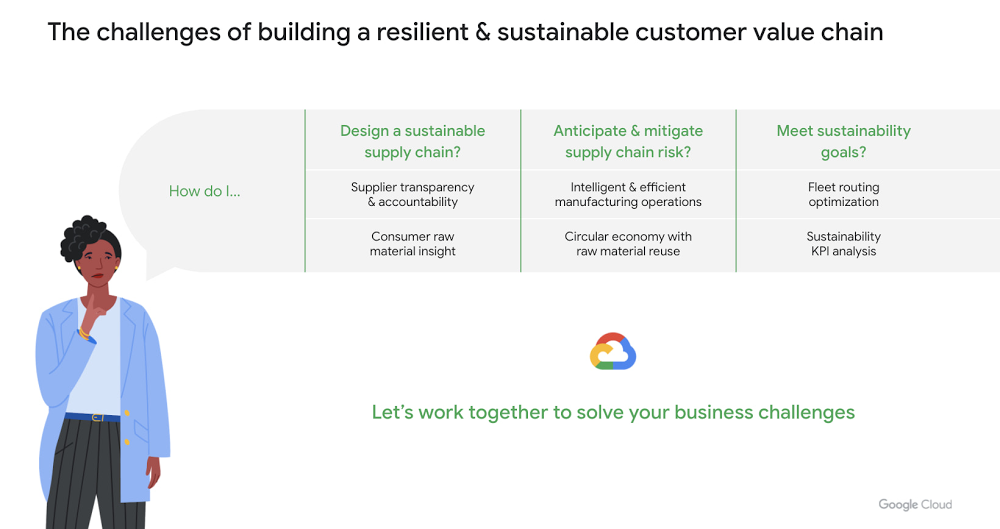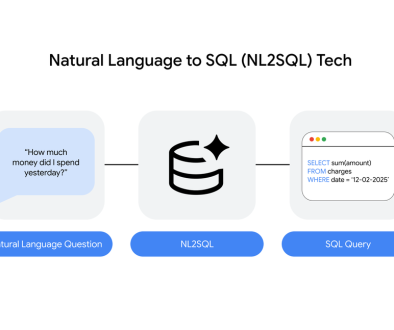GCP – Solving for more sustainable and resilient value chains
The past year highlighted the fragility of global supply chains and logistics networks and the need to adapt to rapidly changing business models and customer preferences. The importance of flexible, resilient and sustainable customer value chains is critical as organizations recalibrate to a post-pandemic world.
Global supply chains are also subject to environmental risks. In 2020, over 8,000 suppliers disclosing through CDP, a global disclosure system for environmental impacts, reported that US$1.26 trillion of revenue is likely to be at risk over the next five years due to climate change, deforestation, and water insecurity1. Organizations are also likely to be challenged with reputational and regulatory risks across their value chain. For instance, emissions from supply chains are on average 11.4x higher than emissions from a company’s direct operations2. In many sectors, supply chains are responsible for over 80% of total greenhouse gas emissions.
There is a strong argument for accelerating efforts to tackle these emissions, as suppliers reported combined savings of US$33.7 billion in 2020 by actively cutting emissions.3
Challenges in creating a sustainable customer value chain
Organizations struggle with achieving sustainable value chain goals largely due to three factors:
-
Limited visibility across the end-to-end value chain to drive transparency and accelerate adoption of sustainable best practices
-
Lack of flexibility to adapt to new business models as highlighted during the pandemic and the rapid shift to e-commerce
-
Limited insight into an organization’s operational decisions and their impact in reducing carbon emissions, preventing data-driven decision making.
How Google Cloud can help
Our mission at Google Cloud is to accelerate your organization’s ability to digitally transform your business. That includes supply chains. With better insights from data you can automate processes more intelligently. With smarter ML models you can optimize systems and routing. With an open platform you can integrate partner solutions. And you can connect your workforce in real time to collaborate up and down the value chain.
Leveraging these technologies, we’re partnering with our customers to tackle the unique sustainability challenges they face to help transform their supply chains.
Enabling sustainable sourcing atUnilever: By combining the power of cloud computing with satellite imagery and AI, Google Cloud and Unilever are building a more holistic view of the forests, water cycles, and biodiversity that intersect Unilever’s supply chain—raising sustainable sourcing standards for suppliers and bringing Unilever closer to its goal of ending deforestation and regenerating nature.
Reducing emissions from last-mile logistics and fleet operations atUPS: UPS leverages Google Cloud smart analytics platform to reduce fuel consumption by 10 million gallons a year, reducing carbon emissions and saving up to $400 million a year.
Reducing manufacturing waste and improving production quality at LG and GlobalFoundries: LG improved defect detection accuracy by 6% and reduced the time to design and train ML models from days to hours using Google Cloud Vision AI. The Vision AI solution was able to reduce waste and increase customer satisfaction and quality at GlobalFoundries.
Reducing packaging at Lush: Lush was able to nearly eliminate plastic packaging by using Google AI to develop an app that leverages AI and augmented reality to recognize products and overlay product information.
In solutions engineering our goal is to take these unique experiences and scale them to help organizations reduce emissions and meet their sustainability goals. To facilitate collaboration along this journey we are creating a program to work with our customers and assess where cloud technology can impact their value chains in an environmentally positive way.
Steps for creating more sustainable value chains
We’ve developed innovative models to tackle challenges from reducing IT costs to data center transformations to IT infrastructure emissions. We’re excited to apply it to our customers’ sustainability priorities and pain points across the supply chain. We will partner closely to build proof of concepts (PoCs) to tackle new opportunities that help customers achieve their sustainability goals.
- We’ll start with benchmarks. We measure where customers are relative to industry benchmarks, to better help them achieve their target goals.
- Next, we’ll assess sustainability and supply chain processes against a maturity curve. This creates a gap analysis to identify areas for improvement.
- We’ll prioritize the areas of focus using factors such as cost reduction, productivity improvement, revenue impact, and environmental and financial risks.
- We’ll map the Google Cloud solutions against your areas of focus identifying where cloud technology can potentially reduce environmental impact and operational costs, and where it can enhance security, compliance, and flexibility.
- With a short list of opportunities, we’ll partner closely with your teams to build PoCs and test the impact of our solutions and ability to scale across your end-to-end value chain.
This is just the beginning of our journey to help address the most challenging problems across the supply chain and partner with our customers to help them achieve sustainability goals. You can learn more about our sustainability efforts and how we’re integrating circular economy principles into our own supply chain to make it more sustainable. Contact us to tell us what you’re solving for and get started. A Google Cloud expert will help you find the best engagement for you. We look forward to helping you achieve your sustainable value chain goals.
1. CDP Global Supply Chain Report 2020
2. CDP Global Supply Chain Report 2020
3. CDP Global Supply Chain Report 2020
Read More for the details.





